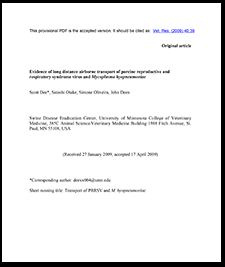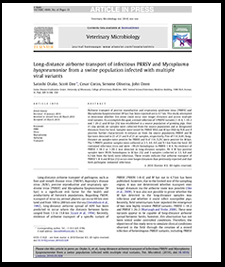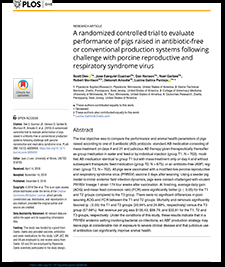Evidence of long distance airborne transport of porcine reproductive and respiratory syndrome virus and Mycoplasma hyopneumoniae
The ability of porcine reproductive and respiratory syndrome virus (PRRSV) and Mycoplasma hyopneumoniae (M. hyopneumoniae) to be transported over long distances via the airborne route was evaluated.
The results arrived at, support the hypothesis that long distance airborne transport of these important swine pathogens can occur.
Long-distance airborne transport of infectious PRRSV and Mycoplasma hyopneumoniae from a swine population infected with multiple viral variants
Airborne transport of porcine reproductive and respiratory syndrome virus (PRRSV) and Mycoplasma hyopneumoniae (M hyo) has been reported out to 4.7 km.
This study attempted to determine whether this event could occur over longer distances and across multiple viral variants.
A randomized controlled trial to evaluate performance of pigs raised in antibiotic-free or conventional production systems following
challenge with porcine reproductive and respiratory syndrome virus
The trial objective was to compare the performance and animal health parameters of pigs raised according to one of 3 antibiotic (AB) protocols.
Under the conditions of this study, these results indicate that in a PRRSV-endemic setting involving bacterial co-infections, an ABF production strategy may leave pigs at considerable risk of exposure to severe clinical disease and that judicious use of antibiotics can significantly improve animal health.
Use of a production region model to assess the airborne spread of porcine reproductive and respiratory syndrome virus
To enhance the knowledge of PRRS aerobiology we used a production region model to quantify infectious virus in bioaerosols, document airborne spread of the virus out to 120 m, identify climactic conditions associated with the presence of virus in bioaerosols, and demonstrate the ability to protect at-risk populations using a system of air filtration.
These findings confirm the importance of the airborne spread of PRRS virus, provide new information regarding its aerobiology and describe for the first time an effective means of disease control that can protect healthy, vulnerable populations of pigs.




